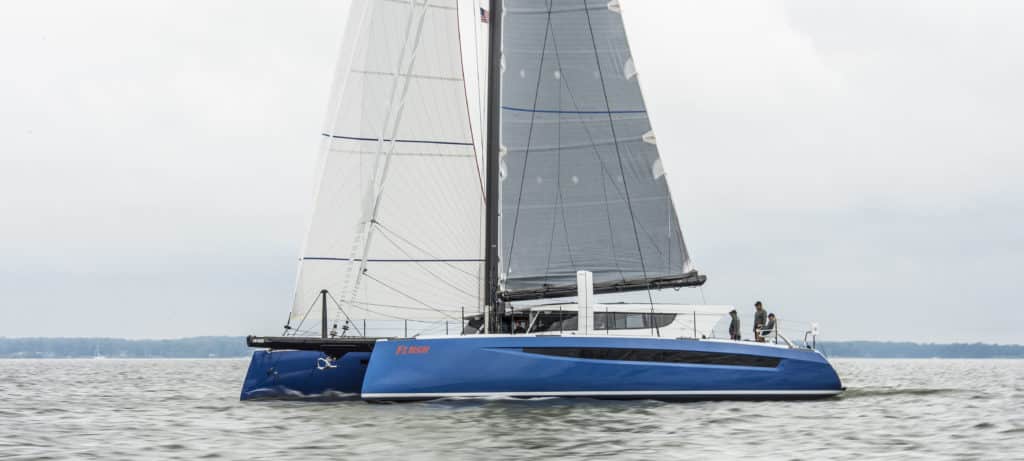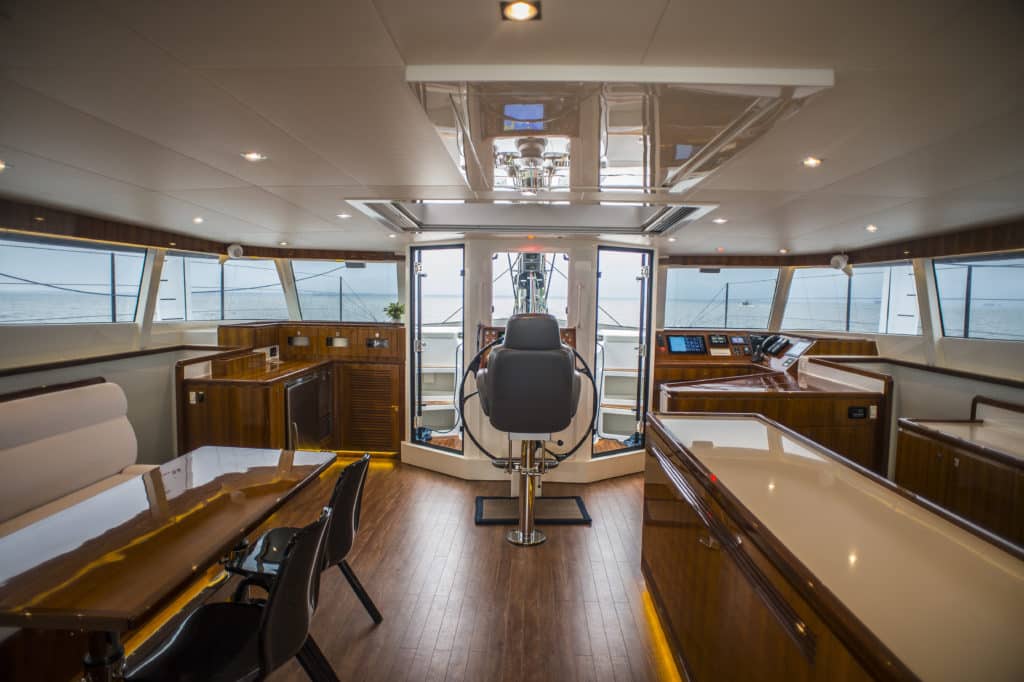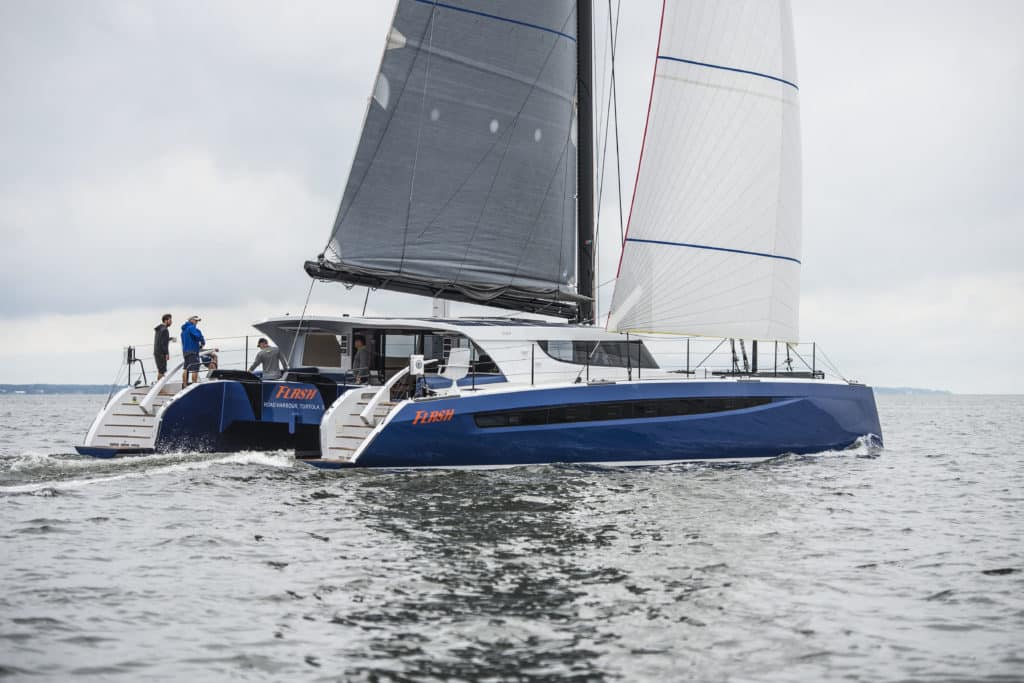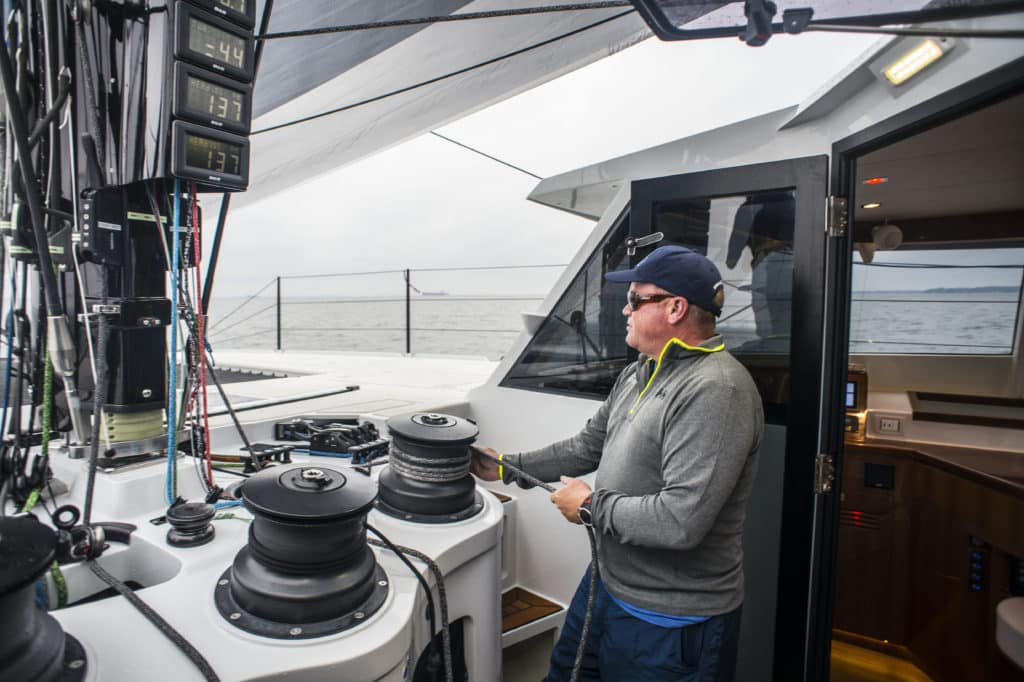
With the HH66 catamaran’s sharp reversed bows pointing into a light northerly, the electric halyard winch winds a square-headed mainsail swiftly skyward. A single crew member assists while standing atop the carbon boom while the rest of the sailing team stands elbow to elbow in the pit, observing the thick halyard tail snaking into its rope well beneath the mast. At their backs, watching through the catamaran’s large glass windshield, is the solitary helmsman, his hands resting upon the polished carbon steering wheel, anticipating the moment he can bear away, unfurl the Code Zero, and watch the boatspeed race to 10 knots in a blink.
The speed build is fluid and easy. There’s no chaos, no clamor of crew grinding the headsail home before scurrying to the rail. Instead, there’s a fine-tune button press or two, and when the Boat of the Year judges — Chuck Allen, Tom Rich and Greg Stewart — finally look up from all the controls and displays at their fingertips, the distant Chesapeake Bay shoreline is blurring past.
It’s said that a big boat dulls any sensation of speed, but with the H66, the judges are feeling quite the opposite.
“The boat immediately comes alive,” says Stewart, who eventually abandons the boat’s inside helm station and takes the best seat in the house: the white carbon helmsman’s chair mounted alongside the tiller. For experienced sailors, the short carbon tillers are perhaps the one simple and distinct detail that immediately separates the HH66 from other cruiser/racer catamarans of this ilk.
“When you’re racing, you’ll be out at the tiller,” says Stewart. “It makes a big difference being where you can better feel the wind and the heel angle. The sight lines through the window and under the jib are good.”
For long passages, or in bad weather, he adds, you can simply duck inside to the big, cushy leather chair.

Even with the inherent friction associated with having two tillers and two wheels connected to the steering system, the feel on the HH66 helm is light and engaging, says Stewart, and that’s partly due to a combination of hull shape and the boat’s deep C-shaped carbon daggerboards. The boat, says Stewart, drives like a well-balanced big boat, not a big rig.
Acknowledging the influence of pioneering Gunboat Catamarans of the past, designs that propelled the high-performance crossover catamaran genre to where it is today, yacht designer Gino Morrelli says the HH Catamarans line — which spans from 66 to a 48-footer in the pipeline — benefits from 15 years of make-and-break development. The HH66’s hull profile is full forward, flatter in the midsection, and bigger in the transoms, says Morrelli, which, when coupled with less rocker than his Gunboat designs, results in better handling in a seaway. Less pitching, he says, is fast.
“Daggerboards have changed dramatically over the years as well,” adds Morrelli. In the old days, boards were short, straight, wide and thick, but as owners and race teams added more horsepower to the sail plan, the boards and platforms weren’t up to increased loads.
“C-daggerboards increase vertical lift and lateral resistance, which dampens pitching,” says Morrelli, “which makes for better all-around performance.”
The HH66 is lightweight for its size, scale and complexity. Teak soles, deck hardware and everything including the galley sink, eventually tip the scale to 46,000 pounds. Weight savings, says Morrelli, is due to the lower cost for carbon today, and HH isn’t afraid to cook the black stuff into the boat wherever they can.
“We’re racing these boats on one hull now,” adds Morelli, “so when we started, we knew it had to be a full carbon boat. The glass windows too can now take the horsepower that’s being put into these platforms.”

It’s easy to become enamored with the luxury-level construction and cabinetry, but all the bells and whistles that will allow an owner to play off-grid are equally impressive. “This is the first boat we’ve seen in a long time where it was as good-looking at the dock as it sails,” says Rich, a custom race-boat builder himself who can spot a shortcut or shoddy workmanship with one eye closed. “With the construction of this boat, I couldn’t find a single thing to complain about,” he says. “It’s really impressive what they’ve done with so many man-hours.”
The judges agree that a boat of this size and complexity demands a full-time boat captain, ideally one that’s involved in the build, the sailing and the upkeep. To race it will also require a few paid hands to get it around the track, and eight to 10 experienced hands, especially for races involving overnight action.
“We’ve made sure this design is race-ready,” says Morrelli. “The 66 is for an owner who wants to race and cruise, but it’s a big boat, and unless an owner has significant experience, they will need a pro or two to help.”
At Stewart’s fingertips in the tiller seat are push-button controls that deliver instant adjustment to the traveler, sheets and daggerboards. Flash has the racing hardware package with upgraded winches, but there is also a turbo-rig version for those who desire ever more power in the sail plan. There’s no doubt about it, says Allen. “This boat is racy, and you feel it right away in the helm, even without the turbo package.”
While the HH66 carries an all-purpose A5 spinnaker, the judges deploy everything else in the fruit basket — a Code Zero, an inner jib and a J1 — as they zigzag up and down the bay. “Everything is on halyard locks, and it’s easy to get everything up and down,” says Allen. “The rigging and the leads are really clean.”

“Clean” and “sophisticated” are the two traits that come up most often in post-sailing discussions. There is sail-control redundancy throughout the boat and enough technology designed into the systems to keep an owner out of trouble, including Ocean Data System’s UpsideUp anti-capsize system, which monitors cap-shroud loads and automatically triggers an alarm, eases sheets or adjusts the autopilot to prevent the boat from exceeding preset parameters.
“I hear it all the time from guys who are sailing all these types of boats; they say it’s the way of the future,” says Rich. “I can see why because the performance is really there with this boat. It’s not just a step beyond what we’ve sailed in the past; it’s steps ahead. It’s going to be a great boat for long-distance point-to-point racing, where you’ve got four or five experienced guys, a navigator and a few passengers who aren’t sitting on the rail the whole time.”
With such sophistication, however, comes the $4 million price tag, but even that, the judges say, is a selling point. To build this same boat domestically, with the same man-hours, says Rich, it would easily be well over $6 million. You get a lot of boat per dollar, he adds, with the potential for a lot of miles and a lot of fast, fun sailing along the way.
At a Glance:
| Designed for | Distance Racing, Globe Trotting |
| Judges Liked | Design Sophistication, Build Quality, Performance |
| Required Crew | 8-10 to Race, Boat Captain/Engineer |
| Price as Tested | $4 Million |









